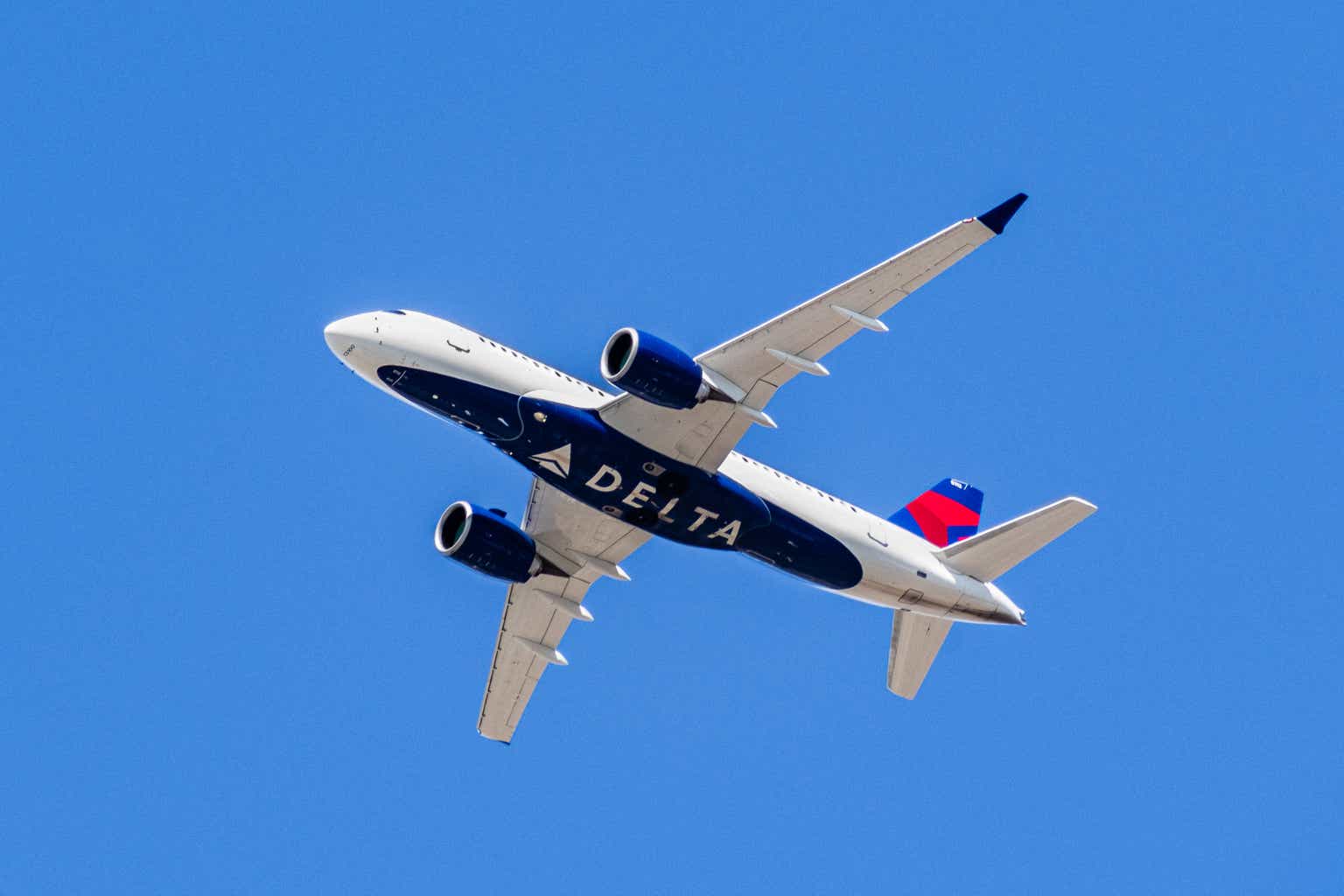Travel
Delta: Better Travel Outlook, Better Stock (Rating Upgrade) (NYSE:DAL)

Sundry Photography
Investment Thesis
In December, I rated Delta Air Lines (NYSE:DAL) as a hold because of my concerns about their potential pension issues and a perceived downward trend in demand for air travel. At that time, I was worried Delta Air Lines pension fund was too highly exposed to private fund investments and the unfavorable market conditions for private equity was a risk factor that we could not ignore. Together with what looked like an impending softening of domestic travel, I rated the stock as a hold until these concerns could be addressed.
However, despite my previous concerns, the broader US travel sector is now exceeding industry expectations, with multiple reports indicating a record-setting summer travel season. In particular, Delta along with other major carriers anticipate a surge in passenger numbers, especially for first-class tickets. What’s more interesting, I think, is that this is not isolated with one airline, but will be felt by the larger industry.
Delta Air Lines has shown a stronger operational performance with record quarterly revenue. Analysts predict that it is poised to continue this momentum with the airline’s projected earnings of $6.63 per share for this fiscal year and strong anticipated free cash flow. This positive financial outlook is supported by this uplift in passenger volumes, which have already surpassed pre-pandemic levels because of a healthier U.S. economy and a buoyant domestic and international air travel market.
Even with the airline industry facing issues such as new aircraft delivery delays and higher operational costs, I have observed that Delta has managed these effectively. The airline’s fleet and route management was adjusted to limit the impact of such constraints and demonstrate its approach to reducing its pension liabilities and improving its balance sheet. In a way, the earlier concerns about its pension fund’s exposure to volatile private equity markets has been somehow carefully mitigated by strong performance that can backfill any underfunded pension obligations.
I believe that Delta Air Lines’ strong financial performance, strategic operational management, and the broader travel sector’s positive trends justify upgrading the stock from a hold to a strong buy. The airline’s resilience in handling industry-wide challenges and capitalizing on the robust demand for air travel positions it well for sustained growth and profitability.
Why Am I Doing Follow-Up Coverage
My initial pessimism about the Airline stemmed from the potential issues such as Delta’s high exposure to private fund investments in its pension fund along with the challenging market conditions for private equity last year. This concern was also exacerbated by indications of softening domestic demand.
However, contrary to the market’s initial fears, the travel sector has experienced a rise in passenger volumes and continues to exceed previous forecasts. As airline executives project a huge recovery in summer travel along with a rise in the number of first-class passengers, I am confident that Delta can benefit from this surge. The increased demand together with fewer pilots creates favorable supply-demand dynamics, ensuring that more airlines can maintain strong pricing power leveraging limited capacity.
I have also observed Delta’s strategy of increasing overbooking rates to maximize revenue. This, I think, is part of a broader revenue management process that the company has adapted for the post-pandemic era, where consumer behavior and travel preferences are rapidly evolving. Despite potential risks involved, this allows the airline to capitalize on the surging passenger demand.
Delta has consistently beaten profit forecasts, which indicate the strong traveler volumes and operational management as rivals face challenges like the 737 MAX crisis. The airline has also declared quarterly dividends that signal confidence in its earnings and cash flow stability. These dividends were unthinkable a few years ago when COVID impacted all airlines.
In addition, the fall in airfares in April, despite a busy summer season approaching, has helped the company in its pricing adjustment in response to fluctuating jet fuel prices. I think that this reduction is not a sign of weakening demand, but a more astute strategy to maintain its edge on passenger volume against its competitors.
The airline industry’s high demand and limited pilot availability also contribute to the shift in the airline’s market and operational strategy as its adjustments, including focusing on lucrative routes and optimizing its fleet, help them to take advantage of the summer travel peak. With these, I believe that Delta deserves a follow-up.
Overview: Travel Demand is Strong
Analysts have observed that the global aviation industry is undergoing an unprecedented surge in passenger traffic in the post-pandemic era. In fact, more passengers are traveling compared to pre-pandemic period, with one-third indicating an increase in travel frequency attributed partly to experiential spending.
Airlines for America anticipates a record-setting 167.1 million travelers during the spring travel period of 2024, up by 6% over the previous year. This growth is consistent across various geographies, as more airlines now offer more flights and larger aircraft to meet demand.
The International Air Transport Association, on the other hand, expects 4.7 billion passengers in 2024, a jump from 4.5 billion in 2019, highly driven by robust consumer demand and the airlines’ capacity management. Overall, the sector anticipates revenues to reach $717 billion in 2024, up 12% year-over-year as a result of increased passenger volumes and yields.
Air travel forecasts to 2030 also suggest a steady recovery and growth trajectory, according to Bain & Company. Annual air travel demand is set to exceed 2019 levels in 2024, with a 59% growth expected in Asia’s intraregional demand from 2019 to 2030. Europe and North America both demonstrate varied growth based on regional dynamics and decarbonization efforts.
There’s also a growing shift towards sustainable travel, according to the consulting group. The activities to mitigate CO2 emissions, particularly in the Nordic countries, will strongly influence travel costs and demand patterns. Sustainable aviation fuel commitments have likewise the potential to impact the growth rates in these regions, which may slow down passenger volumes in some areas.
However, the rise of low-cost carriers continues to reshape the industry, especially in short-haul flights. By 2030, these carriers are expected to capture 48% of the market share in short-haul segments, driven by growth in Europe and Asia.
It is also worth considering the popularity of hybrid work models that have allowed more people to travel while working on their mobile devices. Reports indicate that among the people who belong in this category, they tend to pay for longer stays and more frequent trips to destinations that cater to digital nomads and remote workers. There is also an observed increase in demand for premium travel experiences. Airlines, especially Delta, attract travelers willing to pay for more than just a seat in exchange for luxury and comfort.
However, the industry faces challenges with aircraft shortages that limit their capability to expand seat offerings during peak periods. But they capitalize on it through a stronger pricing strategy and an emphasis on maximizing revenue from available capacity.
Impact of Inflation
Recent data indicates that U.S. consumer prices increased less than expected in April. With inflation resuming its downward trend at the start of 2Q 2024, analysts believe that such a positive development for financial markets will help raise expectations for a September interest rate cut. With cooling inflation, higher-income consumers who have more disposable income, savings and investments will be the first to benefit from reduced inflationary pressures. While producer prices in services and goods have shown strong gains, the broader trend towards cooling inflation will be sustained and most likely drive higher consumer spending on travel and leisure.
Another notable trend is that while economy airline tickets have become more expensive by 9% in the country in 2023 compared to 2019, business class ticket costs have fallen, making premium travel more affordable to those with higher discretionary spending and those who search for value in premium offerings.
Paris 2024
The upcoming 2024 Paris Olympics is expected to be a significant driver for increased air travel, with airlines and industry analysts forecasting a surge in demand. For instance, Air France plans to operate long-haul flights to 85 destinations across 74 countries, including increased flights to the United States, which include services to major airports like Phoenix, Minneapolis, Raleigh, and Los Angeles.
For Delta, on the other hand, it expects that the Olympics will cause a spike in demand for travel to Europe, particularly to France, during the summer months. The company announced that it will focus on premium travelers attending the games.
Valuation
Delta is trading at a very attractive valuation compared to the industrials sector overall. Specifically, the forward P/E Non-GAAP for Delta is 7.94 while the sector median is significantly higher at 19.32. This represents a -58.89% discount relative to the sector. Delta is priced very cheaply compared to its peers in the industrials sector. However, it’s important to note that Delta does not necessarily deserve to trade at the full P/E ratio of the industrials sector, given the unique challenges and risks associated with the airline industry, including cyclical demand, high operational leverage, and sensitivity to external factors like oil prices and economic conditions.
If Delta Air Lines’ forward non-GAAP P/E ratio were to increase to just 12, this would represent a 51.13% upside for Delta’s stock price, assuming all other factors remain constant and the market re-rates the stock based on this adjusted P/E ratio. I think Delta deserves to trade at 12 times earnings because the industry is likely more long run stable post COVID due to supply constraints that should give pricing power. Add in the fact that some peers like Southwest Airlines (LUV) trades at 24.30 times forward earnings, and a 12x P/E target becomes very reasonable.
Risks to Thesis
There has been much research indicating that Americans outside the wealthiest 20% have exhausted their extra savings accumulated during the pandemic, with bank deposits and other liquid assets for the bottom 80% of households by income being lower than their pre-pandemic levels in March 2020 after adjusting for inflation. This is a stark contrast to the wealthiest households, where cash savings are still about 8% above their level when COVID-19 began.
More analysis further highlights the economic divide, which reveals that middle-income earners are already increasingly behaving like their lower-income counterparts in terms of economic indicators. For me, this is concerning since it points to an early sign of a weakening middle class, a crucial demographic for sustained economic growth.
I believe that this will lead lower to middle-income consumers, who have less buffer in their finances, to decrease their discretionary spending. This could include cutting back on travel, especially as they recoup budgets to accommodate essential expenses and higher borrowing costs due to increased interest rates. When inflation exceeds expectations, for Delta, this could mean fewer bookings and a decrease in revenue, which is critical for funding various operational needs, including employee pensions. Delta’s ability to fund its pension is linked to its overall financial health, which relies on consistent revenue streams. If consumer spending drops due to high inflation, Delta could face a double-edged sword through reduced income and increased pressure to meet fixed costs, including pension liabilities.
While this scenario is possible, I think overall Delta Air Lines will continue to perform. Higher income consumers consume a disproportionate amount of airline travel (by miles) due to the needs to travel for business and for leisure. I believe this group will continue to spend, especially with so many catalysts currently in the travel industry. Higher income consumers will keep the skies clear for Delta Air Lines.
Conclusion
I believe that the strong travel data has lessened many of the concerns I had about Delta Air Lines in December. The resurgence in the travel sector, characterized by record-setting forecasts for summer travel and the surge in premium ticket sales, I think, will keep market demand resilient in the coming months.
Delta’s record quarterly revenue and projected earnings of $6.63 per share has shown the airline’s capacity to take advantage of the market. This, along with Delta’s management measures in its pension liabilities and pricing strategies in response to fluctuating jet fuel prices, will be seminal in its future financial performance.
While potential risks such as the depletion of pandemic savings among lower to middle-income consumers could impact discretionary spending on travel, the overall industry momentum and Delta Air Lines market position suggest these concerns can be managed within the broader optimistic outlook.
I believe Delta Air Lines now appears to be a strong buy at this moment because of strong travel demand, effective strategic responses, and attractive valuation.









